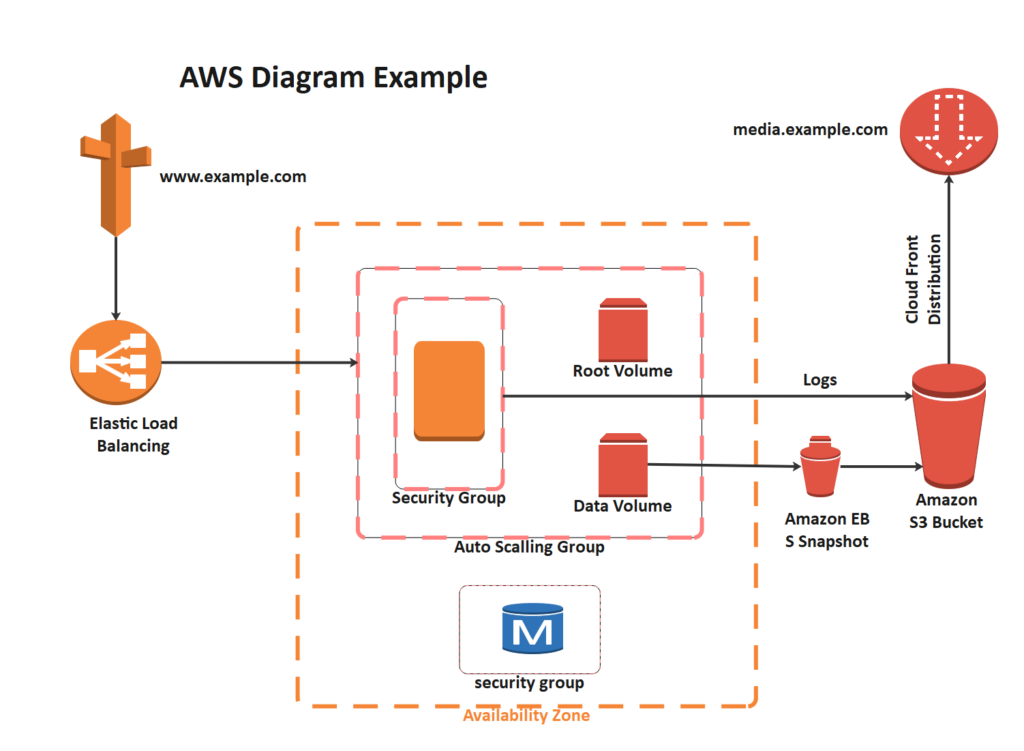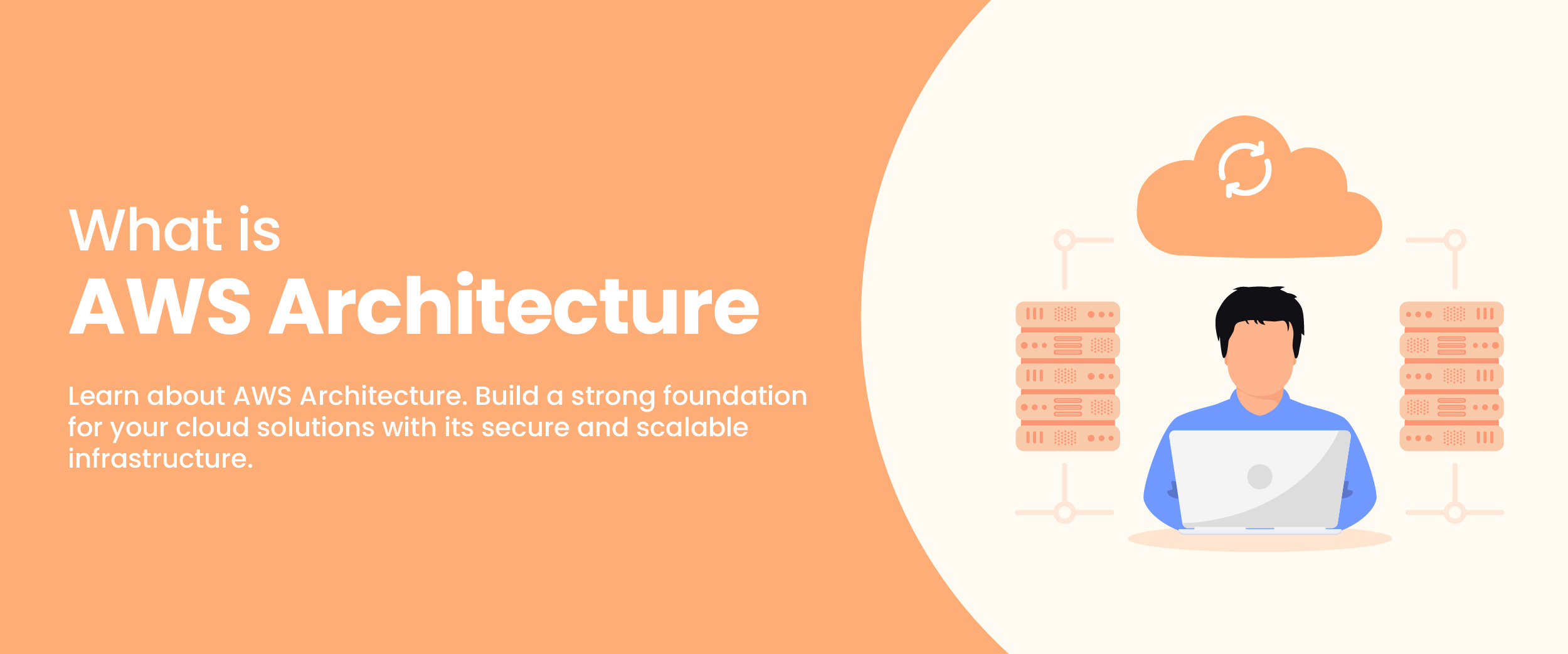What is AWS Architecture?
As more and more organizations look to harness the power of cloud computing for digital transformation, AWS has emerged as a leader in providing reliable and flexible solutions. By 2032, experts predict that the global cloud computing market will reach an astronomical USD 2,321.1 billion with impressive growth rates. This is proof of the importance of getting the right cloud provider for your business. In this blog, we will take you through everything you need to know about AWS architecture, its deployment models, and the components making it a leading platform.
AWS Architecture and How Does It Work?
It provides a secure on-demand platform offering database storage infrastructure services like content delivery and APIs. It also provides customers looking for beginner-friendly options with cost savings. Its “pay-as-you-go” pricing models represent an easily accessible yet robustly built-up foundation capable of delivering high availability and crosscutting scalability considerations. Lastly, it heightens security controls by enabling features like Amazon WAF (Web Application Firewall) integration.
AWS’s functioning is facilitated through these crucial steps occurring within the structure:
- Users register or transfer their domains via emails to AWS servers.
- The registration request and all the essential information get sent to the API Gateway.
- API Gateway provides necessary data about user information onward to the AWS Lambda function.
- Lambda takes over from here, generating emails for the 3rd party systems using the routing system SES.
Types of Deployment Models in Cloud Computing
AWS offers four types of deployment models. They are as follows:
1. Private Cloud
As the name implies, the information on this cloud is kept and maintained in a private repo and away from the public. Any company that wants more robust security and availability would go for this type because this private cloud offers the best security options. Also, the data on a private cloud is hosted internally or externally.
2. Public Cloud
The public cloud is available for the general public to use. Organizations that require an open deployment for public access on the network can utilize the public cloud. This model is ideal for businesses that have varying and growing demands.
3. Hybrid Cloud
It is a mix of all the other types, like private, public, and community clouds. It allows companies to mix and match the features of the different types of clouds to their advantage.
4. Community Cloud
Unlike the private cloud, this community cloud is operated and shared by multiple organizations or companies, especially those with similar backgrounds. The community shares this cloud space to manage, deploy and implement their projects.
What is the AWS Architecture Diagram?

This diagram illustrates the underlying structure of cloud computing services offered by AWS. It demonstrates how CloudFront, EC2 instances, Elastic Load Balancer (ELB), security groups, and Route 53 work with S3 (Simple Storage Service) to facilitate data storage and retrieval through Application Programming Interface calls. It also encompasses configuration servers and finely tuned server mapping capabilities for businesses that need great flexibility at competitive prices.
Custom virtual private clouds are established along availability zones providing reliable redundancy during system maintenance or downtime scenarios. Finally, web servers built on AWS EC2 instantly get auto-scaled across all the necessary resources. ELBs help manage external traffic effectively, highlighting an interconnected weave from many efficient elements. This paves the way towards creating robust scalability within secure infrastructure frameworks when ‘building’ dream applications.
What is the Importance of AWS Architecture?
AWS architecture plays a significant role in ensuring users can access the advantages of cloud-based technologies. It offers many benefits that bolster cloud innovation, such as streamlined operations and reduced workloads, allowing clients to focus on running their businesses efficiently. Moreover, heightened security measures are in place to protect against unauthorized access or data breaches making its ecosystem secure and reliable.
The dynamic scalability, where resources can be scaled up or down depending on demand without any service disruption, makes it an ideal platform capable of accommodating businesses across industries. Plus, relationship integrations with third-party services and tools make it easier for companies large & small alike – enabling them to use products best suited to help reach those goals more efficiently.
Key Components of AWS Architecture
The following are its key components.
1. ElastiCache
ElastiCache makes managing memory cache in the cloud easy, storing important data for increased scalability and reliability. Auto Scaling ensures that application performance is always on point.
2. Elastic Load Balancing
Elastic Load Balancing (ELB) dynamically grows with every request and adjusts capacity according to traffic demand.
3. Load Balancing
Load balancing provides better application performance and improved server efficiency. Usually, a hardware load balancer is used for web applications, but this process becomes even more effective when using Elastic Load Balancing from AWS. It enables traffic to be evenly split between EC2 instances across multiple availability zones resulting in faster overall service delivery and increased reliability.
4. Amazon RDS
Amazon RDS puts relational databases such as SQL Server management firmly within reach. This makes it easy to access and manage databases.
5. Security Management
AWS’s secure environment allows users to confidently deploy their projects securely. It is enabled through Security Group, which works like an inbound network firewall. It lets users customize ports, source IP ranges, and protocols for EC2 instance access.
6. Amazon CloudFront
Amazon CloudFront enables the delivery of various content types (streaming/static or dynamic) stored across multiple global locations while requesting from the nearest point possible. This gives better performance due to increased speed.
7. Elastic Load Balancer
ELBs make directing traffic unusually easy. They also provide the capability necessary for scaling up and down depending on conditions observed by managing weather demands accordingly. They also ensure applications run as smoothly as possible.
You can learn more about AWS features and components by taking an in-depth AWS course.
Advantages of AWS
The key advantages of using AWS include:
- Reliability: The 24/7 service ensures applications and services are seamlessly shifted to other servers when a server fails.
- Backups and Recovery Mechanisms: These make AWS suitable for various industries, even in cases of data loss.
- Limitless Storage Capacity: It comes with no additional costs incurred by users trying to access more space than they need.
- Easier Information Access: Users can access it from anywhere worldwide, provided a good internet connection (depending on account or plan).
- Economical Choice: Since customers only pay according to use, it eliminates hardware installation requirements.
Disadvantages of AWS
Despite the various advantages, AWS has some disadvantages too. These include:
- Difficulty in Transitioning Service Providers: It can be difficult for companies that want to transition from one cloud service provider to another as they have integrated their current applications into a given platform.
- Technical Difficulties: There can be severe issues impacting business operations when internet access is down. Thus, businesses cannot connect with their data or application hosted on the cloud through Amazon Web Services.
Top 5 Pillars of AWS Well-Architected Framework
The AWS framework comprises five essential pillars for designing and maintaining a secure, efficient, and robust cloud architecture.
- <H3> Cost Optimization
Cost optimization is focused on cost-effective resource usage and eliminating unnecessary expenses by adopting a consumption model with economies of scale. It also focuses on avoiding investment in data center operations, analyzing expenditures carefully, and utilizing managed services to reduce ownership costs.
- Performance Efficiency
Performance efficiency centers around using computing resources that adapt well to changing demands/technologies using global deployment, serverless architectures, or comparative testing.
- Operational Excellence
The primary focus is on reliability, agility, and performance. It is essential to standardize and manage workflows effectively. To achieve this goal, one must execute operations with code, make consistent modifications over time; evaluate for unforeseen cases; gain from operational events and mistakes made; and stay updated about the latest procedures used operationally.
- Security
Security emphasizes protecting access management, where security procedures are applied at all levels. It is done by implementing the principle of least privilege and enabling traceability besides automating best practices.
- Reliability
Reliability looks forward to system recovery from failures or changes in demand rates via automated backup plans and horizontal scalability alongside automatic failure recoveries.
Conclusion
AWS is a leader in cloud computing, enabling businesses to leverage the power of this technology and stay ahead. With its various features, organizations can make informed decisions about whether AWS is the right choice for their operations. By understanding how all components work together in AWS architecture, users can maximize their potential with the help of one of the most trusted names today.






